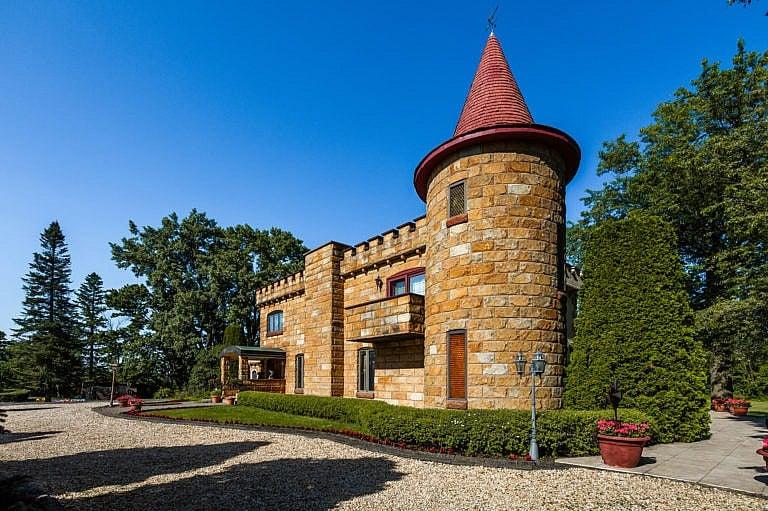A car dealer built a medieval-style castle in Quebec—and it’s on the market for $1.8 million
If this castle in small-town Quebec sells, it’ll be a record price for the area

Share

In L’Assomption, a town of 23,000 people located 50 kilometres north of Montreal, stands a stone castle—known, unsurprisingly, as the Stone Castle. The place was only built about 50 years ago, but looks like a Romanesque structure from medieval Europe, with painted ceilings, a stately dining room surrounded by textured archways and a 30-foot-tall turret. All of it, she thought, was reminiscent of the Romanesque structures of medieval Europe. Realtor Alfee Kaufman was shocked when she first toured the place. “This may be the most unique home I’ve ever listed. It’s not something you expect to witness in this era.”

The regal home was the brainchild of Robert Couteux, owner of a car dealership, who died earlier this year. A Quebec native, Couteux spent much of his 20 travelling Europe and admiring old castles in France and Spain. In 1973, as he neared his 30th birthday, he bought an acre of land in L’Assomption with his wife and embarked on an ambitious project to build what would become a family home for the couple and their two young sons.
READ: This snow-white castle in B.C. could be yours for $1.65 million
The lot was five feet below street level, so he began by pouring several tons of soil to elevate the yard. He then sourced marble from Israel and stones from a quarry in Indiana as the main building materials. Unable to find local contractors who specialized in castle-building, he enlisted architects and artisans from the U.S., France, Italy and other parts of Europe who specialized in churches and old-world homes.
Couteux’s team erected the frame in 1973, then hit a snag—a provincial construction strike forced them to build in secret. The crew boarded the windows and parked 100 yards from the construction site, continuing work and ultimately finishing the project in 1975. By then, it stood in its current form: a two-storey fortress with a yellow facade and red turret.

Inside, they fashioned stone and concrete into majestic ceilings that flow downward and blend into the walls. They also surrounded a joint dining and family room with stone pillars and arches; they crafted the fireplace with the same material. The dining room ceiling, meanwhile, is a collection of recessed copper tiles with paintings by an Italian artist. “In those main rooms, everything down to the carpets is custom designed,” said Kaufman. She says an appraiser estimated that building this house today would cost approximately $3 million.

Most of the art and decorations are original. Right off the entrance, a switchback oak staircase rises above an eight-foot bay window and a custom tapestry of a boy on a horse. Kaufman said the family cherished the painting, as its creator intended for the boy to look like an older version of their two-year-old son. Upstairs are three bedrooms, including the primary one, which has a walk-in closet and a balcony that peers onto the backyard. The owner also made good use of the attached garage by fashioning it into a cinema room with a movie screen and a projector, and finished the basement to fit in a second family room. The only part of the home that hasn’t been used to its potential, said Kaufman, is the tower—the two stories mostly serve as storage.
READ: Inside Manoir Blackswan, an extravagant modern-day palace in Montreal’s suburbs

Outside, the backyard is nearly bare, though the east yard features a dignified bronze fountain. Couteux adorned the front of the lot with two pillars and a silver gate; beyond the gate is a meandering stone pathway that leads to the solid oak front door, flanked by gargoyles. Kaufman said this imposing front did little to stop strangers and tourists from circumventing the barriers for wedding or vacation photos. Several production companies also have reached out to Couteux over the years for permission to use the house as a backdrop for movies; he always turned them down to avoid damaging his masterpiece. The home is a local icon: years after the build, the family witnessed miniature replicas being sold at the town’s Christmas market.

Now that its creator has died, the family wants to sell the property to someone who will appreciate architecture as much as he did. Kaufman listed the property in early August with every piece of furniture and art included, for $1,795,000. The price, while appearing shockingly affordable to the average Torontonian or Vancouverite, would constitute a record-breaking area sale. Kaufman has yet to entertain an offer, but she said the family is not in a rush to sell. “We knew from the outset that this place might take time to go, because it requires a particular buyer; perhaps someone from another country more familiar with this type of construction,” she said, adding that CMHC’s two-year foreign buyer ban, effective since January 2023, has hampered the marketing process. Kaufman said her clients hope the eventual buyer appreciates the modern castle as much as the family patriarch did. “I see nice homes every day, and yet this craftsmanship stands out no matter where you are shopping in the province,” she said. “It’s a passion project like I’ve never seen.”
